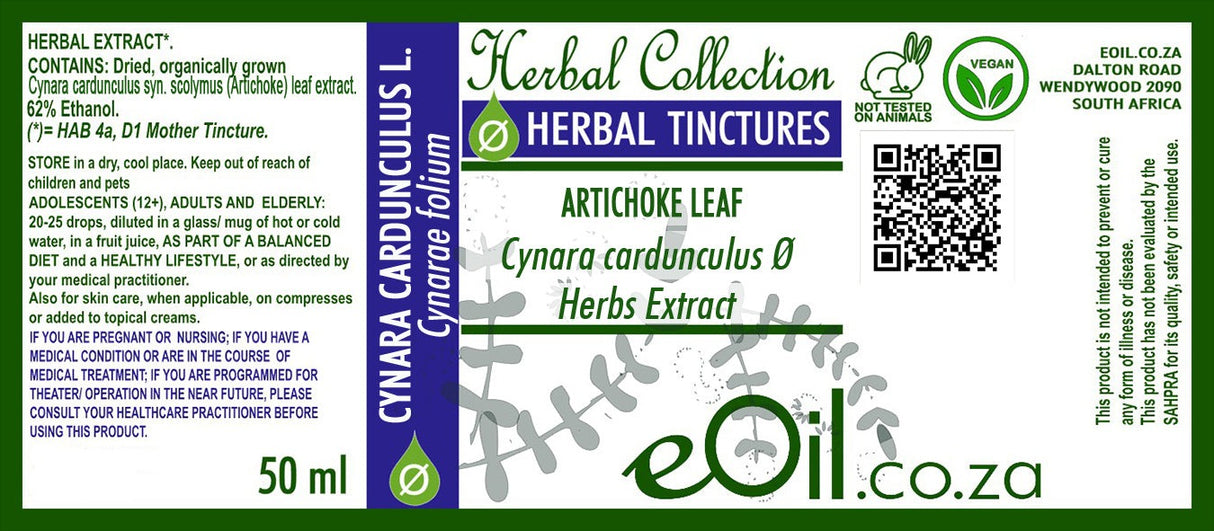Artichoke leaf - Liquid Herbal Extract
Artichoke leaf - Liquid Herbal Extract - 50 ML is backordered and will ship as soon as it is back in stock.
Description
Description
Understanding Mother Tinctures & Glycerines
Support your body's most important detoxification pathways with our Artichoke Leaf Tincture. This is a classic European "bitter tonic," revered for centuries as a powerhouse for the liver and digestive system.
Key Benefits & Uses:
Superior Digestive Aid: This is its #1 use. By promoting bile flow, Artichoke Leaf is exceptionally effective at helping the body digest fats. It's a "go-to" remedy for relieving that heavy, full feeling, indigestion, bloating, and gas, especially after a rich or fatty meal.
Natural Liver Support & Detox: A healthy bile flow is essential for liver health. This tincture helps support the liver's natural detoxification processes, allowing it to function optimally and flush out unwanted toxins.
Supports Healthy Cholesterol: This is its other major, well-researched benefit. The active compounds in Artichoke Leaf are traditionally used to help support the maintenance of healthy cholesterol levels.
Skin Health: A happy, functioning liver is directly linked to clear, healthy skin. By supporting your body's detox pathways, this tincture can be a great support for a clear complexion.
Important Cautions:
Do NOT use if you have gallstones or a bile duct obstruction.
Do not use if pregnant or breastfeeding.
Consult a healthcare professional before use if you have allergies to the Asteraceae family (daisies, ragweed, marigolds).
IDENTIFICATION
Common Name: Artichoke Leaf Extract
Latin Name: Cynara scolymus
Plant Family: Asteraceae
Part Used: Leaves
Extraction Method: Alcohol tincture
INCI Name: Cynara Scolymus Leaf Extract
CAS Number: 84012-14-6
EC Number: 281-659-3
Artichoke Leaf Herbal Liquid Extract Tincture is a potent preparation made from organically grown Cynara scolymus leaves.
The leaves are carefully harvested at peak potency and extracted in organic alcohol to preserve the beneficial compounds.
This concentrated liquid extract offers a convenient way to harness artichoke's properties for digestive and liver health.
TRADITIONALLY USED FOR
Traditional Uses
Artichoke leaf has been used for centuries in traditional medicine systems, particularly in Europe, for:
- Supporting liver health and function
- Aiding digestion and relieving indigestion
- Lowering cholesterol levels
- Stimulating bile production
- Reducing bloating and flatulence
- Supporting kidney function
Modern Research
Modern studies have found evidence to support many of artichoke's traditional uses:
- Antioxidant and hepatoprotective effects
- Choleretic (bile-stimulating) activity
- Lipid-lowering effects
- Potential benefits for digestive issues like dyspepsia and irritable bowel syndrome (IBS)
- Possible blood sugar regulating effects
However, more large-scale clinical trials are still needed to conclusively prove many of its purported benefits.
How to Use
- As a tincture: Take 2-4 ml (40-80 drops) in a small amount of water, 2-3 times daily.
- For tea: Add 15-20 drops to hot water.
- Can be added to smoothies, juices or other beverages.
Digestive Support Tincture:
- 2 ml Artichoke Leaf Extract
- 1 ml Peppermint Extract
- 1 ml Dandelion Root Extract
Mix extracts and take 1-2 ml as needed for indigestion or bloating.
Liver Support Elixir:
- 1 cup warm water
- 1 tsp honey
- 20 drops Artichoke Leaf Extract
- 10 drops Milk Thistle Extract
Mix ingredients and drink to support liver health.
CAUTION
Store in a cool, dry place, away from light. Keep tightly closed, away from the reach of Children and pets.
Do not exceed the daily dose.
This product is not intended to prevent or cure any form of illness or disease.
If you are pregnant or nursing ; If you have a medical condition or are in the course of medical treatment ; If you are programmed for theater/operation in the near future, please consult your healthcare practitioner before using this product.
This product cannot replace a varied and balanced diet and a healthy lifestyle.
This product has not been evaluated by the SAHPRA for its quality, safety or intended use.
For More Information please check our General Safety Herbal products Page

Artichoke leaf - Liquid Herbal Extract - 50 ML is backordered and will ship as soon as it is back in stock.




